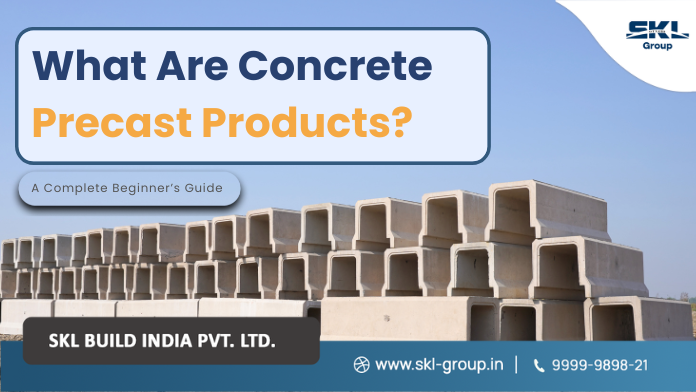The construction business is transforming quickly, and one of the most revolutionary construction materials for today's infrastructure is precast concrete products. Precast concrete can be utilized for everything from bridges and walls to drainage systems, electrical and telecommunications boxes, and architectural panels. Precast concrete products are everywhere! What exactly are these products, and why are builders and engineers so excited about them?
If you are a newcomer to construction or simply interested in how modern construction works, this article will walk you through everything you need to know about precast concrete products: what they are, how they are made, their advantages, and uses.
What Are Precast Concrete Products?
Precast concrete building products are construction components that are cast and cured in a controlled factory environment, and then transported to the building construction site. Precast products are built in contrast to conventional concrete (cast-in-place), which is poured and hardened onsite; precast products are manufactured off-site under rigorous quality control.
Precast components use lots of different precast products and can be as small as an architectural panel or as considerable structural elements such as beams, columns, slabs, pipes, and retaining walls. After precast products have been manufactured, they are then transported to the site for assembly, kind of like building blocks for construction. The process to get it from the manufacturing plant to an efficiency of building it would be order of magnitude faster than other cement methods.
Manufacturing Process of Precast Concrete Products
Creating precast concrete products requires a series of specific steps aimed at ensuring quality, durability, and consistency:
Design/Planning
Every precast product begins with a structural analysis and design. Engineers rely on either 3D modeling or CAD drawings - even ultra-modern, 3D scanning technology is sometimes used - that guarantee each piece will fit perfectly into the final construction.
Mold Preparation
The molds (or forms) can be created of steel, fiberglass, or rubber, depending on the required shape and finish. The molds are then reused, making precast production cost-effective and environmentally friendly.
Mixing and Pouring
The high-quality concrete, often combined with admixtures and reinforcements, is poured into molds. Because this process happens indoors, the temperature and humidity can be regulated for the ideal curing environment.
Curing and Finishing
The concrete remains in the mold until it achieves the desired strength, at which time the precast units are removed from the molds and are finished and inspected for defects.
Transportation and Installation
When the units are complete, they are transported to the construction site using either cranes or trucks, and can be installed in a rapid time with little labor and disruption.
Types of Precast Concrete Products
Precast concrete encompasses a remarkable range of products in both infrastructural and architectural applications for construction:
1. Structural Products
Precast columns and beams, wall panels, floor slabs, stairways, and landings
2. Architectural Products
Facade panels, decorative cladding, and boundary walls.
3. Infrastructure Products
Manholes, drainage pipes, culverts, utility vaults and tanks, precast barriers and retaining walls.
4. Custom Products
Modular components of buildings, sound barrier walls, security walls, and compound walls.
The great range of versatility of precast makes it a good option for the developer, contractor, and government projects.
Precast vs. Cast-in-Place Concrete
| Feature | Precast Concrete | Cast-in-Place Concrete |
|---|---|---|
| Manufacturing | Off-site in a factory | On-site |
| Quality Control | High, under controlled conditions | Variable, weather-dependent |
| Installation Speed | Fast, ready-made units | Slow, requires on-site curing |
| Labor Requirement | Less labor-intensive | High labor demand |
| Weather Impact | Minimal | Affected by the climate |
| Durability | More consistent | Depends on site conditions |
Precast concrete clearly offers advantages in efficiency, quality, and durability, especially for large-scale projects.
Applications of Precast Concrete in Modern Construction
Precast concrete is utilized in virtually all sectors of construction, including:
Residential Buildings: Wall, slab, and staircase systems for apartment buildings and villas.
Commercial Construction: Office buildings, parking garages, and shopping malls.
Industrial Buildings: Warehouses, manufacturing plants, and distribution centers.
Infrastructure: Roads, bridges, subway stations, and tunnels.
Public Spaces: Perimeter walls, street furnishings, and sound barriers.
Its flexibility and versatility will enhance sustainability in small and large developments alike.
As nations see urban populations increase and construction schedules shift toward a shorter attention span, precast concrete allows developers to achieve a slower build speed but still creates quality-controlled products. It remains relevant to contemporary topics like modular construction, smart infrastructure, and various green building certifications.
To that end, government provisions for sustainable, affordable housing are motivating a more aggressive use of precast technology in India and other rapidly urbanizing regions.
Conclusion
Precast concrete products have revolutionized the design and construction of modern infrastructure. With unparalleled strength, speed, and sustainability, precast technology gives developers the ability to complete projects promptly without sacrificing quality or performance. Precast concrete is suitable for everything from residential construction to large-scale industrial and infrastructure projects, and precision and long-term performance are the hallmarks of precast concrete.
We manufacture precast concrete products of the highest quality to meet the various needs of the industry. With the latest production facilities, rigorous quality control, and a commitment to innovation, SKL Build India Pvt. Ltd. provides manufacturers with solutions that save time, minimize costs, and deliver long-lasting performance.

